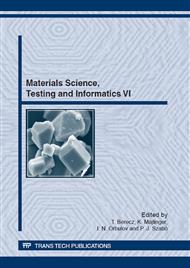[1]
Cs. Balázsi, Z. Kónya, F. Wéber, L. P. Biró, and P. Arató, Preparation and characterization of carbon nanotube reinforced silicon nitride composites. Mat. Sci. Eng. C 23/6-8 pp.1133-1137 , (2003).
DOI: 10.1016/j.msec.2003.09.085
Google Scholar
[2]
J. Tatami, T. Katashima, K. Komeya, T. Meguro, and T. Wakihara, Electrically conductive CNT-dispersed silicon nitride ceramics. J. Am. Ceram. Soc., 88, p.2889, (2005).
DOI: 10.1111/j.1551-2916.2005.00539.x
Google Scholar
[3]
B. Fényi, N. Hegman, F. Wéber, P. Arató, and C. Balázsi, Si3N4 alapú kerámia kompozitok elektromos vizsgálata. Jövőnk Anyagai, technológiái, 139. évf. 6. sz. pp.: 41-46, (2006).
Google Scholar
[4]
Cs. Balázsi, et al., Development of CNT/Si3N4 composites with improved mechanical and electrical properties. Composites, Part B 37 pp.418-424, (2006).
DOI: 10.1016/j.compositesb.2006.02.006
Google Scholar
[5]
Cs. Balázsi, Z. Kónya, F. Wéber, L. P. Biró, and P. Arató, Preparation and characterization of carbon nanotube reinforced silicon nitride composites. Materials Sceince and Engineering C 23 pp.1133-1137, (2003).
DOI: 10.1016/j.msec.2003.09.085
Google Scholar
[6]
Cs. Balázsi, Development of multifunczional silicon nitride based nanocomposites. Materials Science Forum Vol. 659. ISSN 0255-5476 pp.121-126., (2010).
DOI: 10.4028/www.scientific.net/msf.659.121
Google Scholar
[7]
J. Pfeifer, et al., Tribology study of silicon nitride-based nanocomposites with carbon addtions. Materials Sceince Forum ISSN 0255-5476 Vol. 659. pp.235-238., (2010).
DOI: 10.4028/www.scientific.net/msf.659.235
Google Scholar
[8]
C.P. Dogan and J. A. Hawk, Microstructure and abrasive wear in silicon nitride ceramics. Wear 250, pp.256-263., (2001).
DOI: 10.1016/s0043-1648(01)00649-4
Google Scholar
[9]
Struers, LaboPol-21 Instruction Manual, Type No: 529, Grinding and polishing machine . (1996).
Google Scholar
[10]
G. Ellsner, H. Hoven, G. Kiessler, and P. Wellner, Ceramics and Cermaic Composites: Materialographic Preparation. New York: Elsevier Science Inc., (2005).
Google Scholar
[11]
Zs. Koncsik, M. B. Maros, and L. Kuzsella, Si3N4/SiC/grafit kerámia kompozitok mechanikai tulajdonságai. GÉP, LXI. évf. 3. szám, pp.10-15., (2010).
Google Scholar


